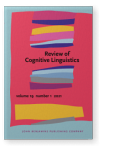Vol. 19:1 (2021) ► pp.80–110
How metaphoremes emerge
Case studies of Chinese verb metaphors
According to the dynamic view of metaphor, the complexities of metaphorical expressions are emergent products of language use. However, this view lacks an explicit mechanism to account for the process. This paper puts forward a model named single-scope integration network with entrenchment (SINE), and uses if-then rules in the model to explain the temporal order and regularities that the metaphoremes of a metaphor should follow in their emergence. The validity of the model is tested in the case studies of Chinese verb metaphors, which reveal four if-then rules that govern the metaphoreme emergence of Chinese verb metaphors. These if-then rules are obtained via the analysis of the occurrence order of metaphoremes by performing DepCluster, a machine learning tool for collostruction generation, over a large-scale diachronic corpus. The case studies demonstrate that the proposed model is applicable to Chinese verb metaphors.
Article outline
- 1.Introduction
- 2.Complexities in the dynamic view of metaphor
- 3.Single-scope integration network with entrenchment
- 4.Uncovering emergence regularities with SINE
- 4.1Collostruction as metaphoreme
- 4.2Obtaining collostructions with DepCluster
- 4.2.1Diachronic corpus
- 4.2.2Collostruction collection procedure
- 4.2.3Collected collostructions
- 4.3
if-then rules
- 4.3.1Metaphor initialization rule
- 4.3.2Focused structure rule
- 4.3.3Non-focus structure rule
- 4.3.4Source-target rule
- 5.Conclusion
- Acknowledgements
- Notes
-
References
